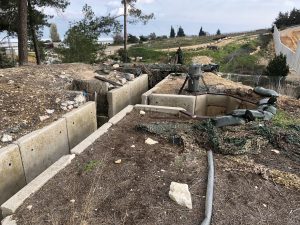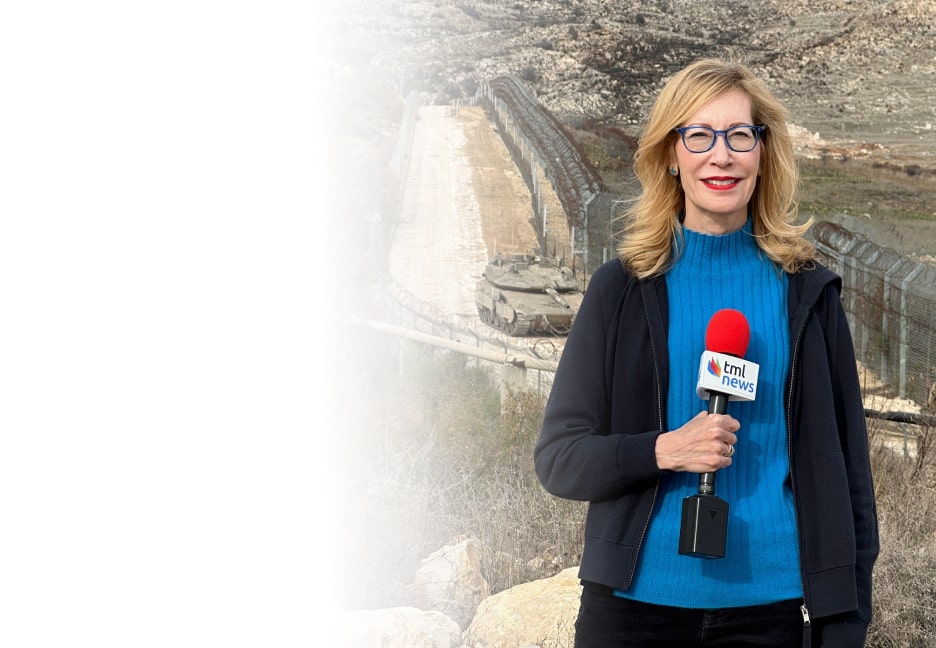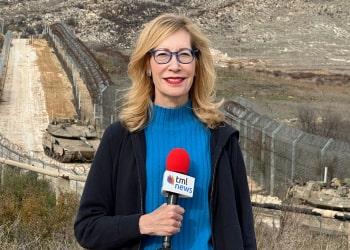IDF to evacuate if conflict erupts, but many residents say they will not leave
Perched atop the Naftali Mountain Range in northern Israel, the Misgav Am kibbutz has a stunning view of the Upper Galilee. On a recent rainy afternoon, a rainbow stretched over the tapestry of colors in the valley below. A serene picture at a tense time.
Misgav Am sits on the Blue Line—the United Nations-designated demarcation between Israel and Lebanon. At its nearest point, Lebanese territory is within a few meters from the Israeli border, close enough to throw a rock across.
Misgav Am was attacked during the last major war between Israel and Hizbullah in 2006 and would again find itself in the line of fire if another conflict erupts.

(A bunker in Misgav Am)
“All these hillsides are honeycombed. There’s hundreds of tons of missiles and mortars and rockets,” said Aryeh Ben Yaakov, who has lived on Misgav Am since 1965. He is one of close to 300 residents of the historic kibbutz which is also one of Israel’s oldest.
Ben Yaakov, a farmer and tour guide, says the community is well protected by the Israel Defense Forces (IDF) and by the residents themselves.
“We’re not worried. We sleep well,” he told The Media Line on a recent afternoon while overlooking the Lebanese village of Adaisseh on the opposite side of the valley. “[Hizbullah] is worried. If they mess with us this [Lebanese towns] will all be destroyed and the soldiers won’t have a place to come home to. So, it’s quiet even though they do a lot of blustering.”
Nevertheless, Hizbullah poses a clear and present danger to Israel. It has an estimated 130,000 to 150,000 short-, medium- and long-range rockets and missiles and a fighting force estimated at 50,000 soldiers, including reservists.
Some analysts believe there may be as many as 1,500 to 2,000 rockets fired into Israel each day during the next war, compared to about 130-180 daily during the 2006 confrontation.
As such, the IDF confirmed to The Media Line that it has increased the number of Iron Dome anti-missile defense batteries in northern Israel and has evacuation plans in place for the border communities, first the ones within four kilometers of Lebanon, then working outwards to nine kilometers from the Blue Line.
“They [IDF] are making us understand that the next war will be a different game, completely different,” said Tali Lev, head of customer relations for Misgav Am who is originally from Long Beach, New York but has lived on the kibbutz for almost five years.
This holiday season, give to:
Truth and understanding
The Media Line's intrepid correspondents are in Israel, Gaza, Lebanon, Syria and Pakistan providing first-person reporting.
They all said they cover it.
We see it.
We report with just one agenda: the truth.


Lev is married with a two-year-old son and says there are numerous bomb shelters for people if there is an attack. For security reasons, however, she did not want to say exactly where they were located or specifically where people would be evacuated to.
“If anything happens in terms of missiles, we can run into shelters straight away,” Lev said. “Basically, there are soldiers here with us [24 hours per day]. So they’re here to help guard and if anything happens they can protect us. We know everything we are supposed to do in case of an emergency, like if there’s a breach into the boundaries of the kibbutz.”
The IDF built a 30-foot high concrete wall along the border in Misgav Am to prevent such infiltrations, learning a lesson from the cross-border attack by Hibullah that ignited the 2006 conflict.
There’s a similar wall separating the border town of Metula from Lebanon. The 1,200 meter concrete barrier is lined with sensors and infrared cameras. It was constructed to protect residents from sniper fire or rock attacks from the nearby Lebanese town of Kafr Kila.
Lev said the IDF has made clear to Misgav Am residents that if another war erupts they will need to evacuate. “The only people who are going to stay here at the beginning are men who can help with the situation,” he explained, noting that many of them are armed and well-trained. “But they are going to be evacuating people this time and [the residents] know it.”
On the day this reporter and a photographer visited Misgav Am, there was a United Nations patrol on the Lebanese side of the border along with what appeared to be a television news crew. A UN helicopter was flying over the Lebanese side of the Blue Line.

Rainbow Over the Galilee (Photo: John Huddy/The Media Line)
Lev said she not only sees UN peacekeepers but Hizbullah fighters as well. The Lebanese Shiite organization’s yellow flags are noticeable across the landscape.
“They want to make sure we know they are here and active,” Lev said in reference to Hizbullah, before qualifying that she does not live in fear of another attack even though she the IDF has warned that the next round of fighting will be more violent. “I’m still here. I will still be here in the future as well. We’re listed to build our own home. Everywhere is scary in the world. You could walk around anywhere in Israel, let’s say in Jerusalem, people get shot at, stabbed, and not even just here. In the [United States] anybody could go into any sports shop and buy a weapon.”
In fact, The Media Line interviewed Lev just a day before a deranged gunmen murdered 17 people at a Florida High School.
Many of the residents of Israel’s border communities feel a sense of peace and security despite living so close to hostile countries, including Syria. These nations are developing, or trying to develop, precision guided weapons with the help of Iran. Israeli leaders have said that this constitutes a red line, along with Tehran’s growing military entrenchment in Syria and Lebanon and support for its proxies like Hizbullah.
Israeli Prime Minister Binyamin Netanyahu said last week following the destruction of an Iranian drone and the subsequent downing by Syrian missile fire of an Israeli F-16 fighter jet, that his government would not limit its military activities in Syria.
He conveyed the same message Sunday at the Munich Security Conference in Germany, holding up a charred piece of the Iranian drone, shot down by an Israeli attack helicopter. “Mr. Zarif, do you recognize this? You should, it’s yours,” Netanyahu quipped, his comments aimed at the Iranian foreign minister. “You can take it back with a message to the tyrants of Tehran—do not test Israel’s resolve.”
Israel is thus concerned about Hizbullah launching attack drones against the border communities.
“Everybody knows something is going to happen we’re just waiting to see when,” Lev said, adding that even when the code red rocket-alert sirens recently went off people were undeterred and continued with their normal lives. “We still had our picnic outside…we didn’t just run into shelters. We stayed put knowing that if anything serious happens there will be another siren, or different siren, or we will get evacuated.”
There is an air of confidence among many living in the north, evidencing a trust in the IDF’s ability to defend them and, if needed, inflict heavy damage on Hizbullah.
“We rely absolutely on the army and ourselves, at all times,” Ben Yaakov said, holding up his jacket to reveal a holstered .45 caliber handgun. “We know what we’re doing. We know how to live here.”
Still, the threat of war is real, one that could erupt on several fronts.
The Druze community of Majdal Shams in the Israeli-controlled Golan Heights lives in the shadow of Mount Hermon. Its inhabitants regularly hear the code red warning sirens along with the actual fighting across the border in Syria. Last fall, a member of the Majdal Shams community was wounded by spillover gunfire.
Recently, dozens of people gathered in the village center for a pro-Syria rally. Several residents speaking on condition of anonymity told The Media Line that the community holds such demonstrations not so much in support of the Syrian regime, but more so, as a show of solidarity with their families and friends on the other side of the border, some of whom have been massacred during the war.
In November, for example, nine Druze living in Hader, located in the Syrian Golan Heights, were killed and more than twenty wounded in two terrorist attacks by the Salafist jihadist group Nusra Front. Hader is located about four kilometers from the Israeli border and about 15 kilometers from the Syrian city of Quneitra.
Following the violence, hundreds of Israeli Druze residents gathered at the border to support their relatives on the other side. A group of Druze men pushed through the security fence, before Israeli forces gathered them up and returned them to Israel. After the attack, the IDF said it would help protect Hader’s Druze residents, a rare announcement of potential Israeli involvement in the Syrian conflict.

(A pro-Syrian demonstration in Majdal Shams)
At the base of the Majdal Shams village, houses are situated along the barbed-wire and sensor-lined Syrian border security fence. It is closely monitored by IDF patrol vehicles and an observation point above the village.
The residents of Majdal Shams, like Esmet Mree, can sometimes hear the artillery fire and gun battles in the distance.
“Two years we’ve been living here. It’s very quiet. We don’t feel we are on the border,” Mree told The Media Line, as he looked out of his living room window at the border security fence and the mountains in the background. “But I would rather have it without the fence and open for all people.”
Mree said he would not leave his home or village if a war erupted even if ordered to evacuate.
For his part, Aryeh Ben Yaakov said he would die defending Misgav Am. “Nobody gets us off the mountain,” he said shaking his head. “To a certain extent you have to be a little fatalistic. If God wants you he’ll take you. Those of us who live up here understand that. If I have to go, I’m going defending my home. Everybody dies some time. You get born and then you’re gonna die. How you live is what’s important.”
Driving back to Jerusalem through the Golan Heights, the mine fields lie in stark contrast to the dairy farms they run adjacent to. Abandoned Israeli tanks from the 1973 war still have their barrels aimed at Syria. They are the remnants of past wars in a country that may be on the brink of another one.